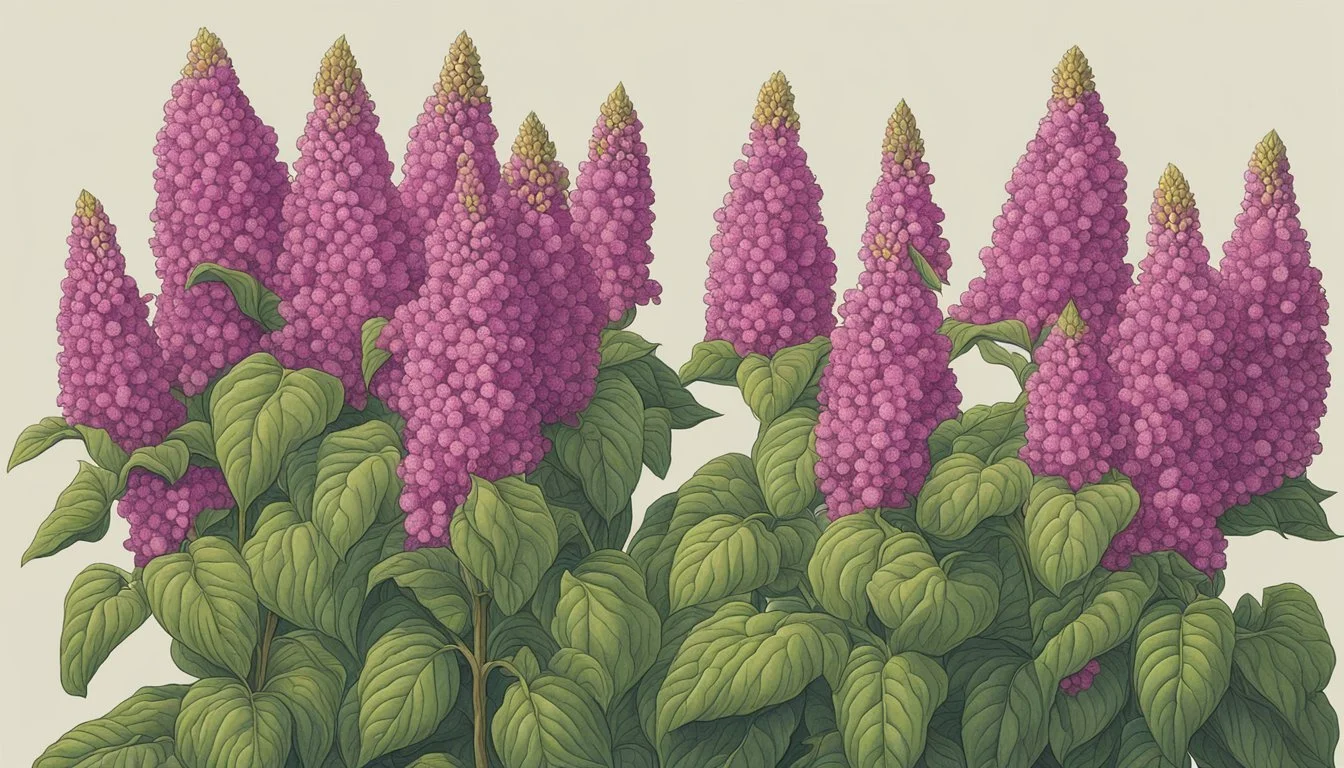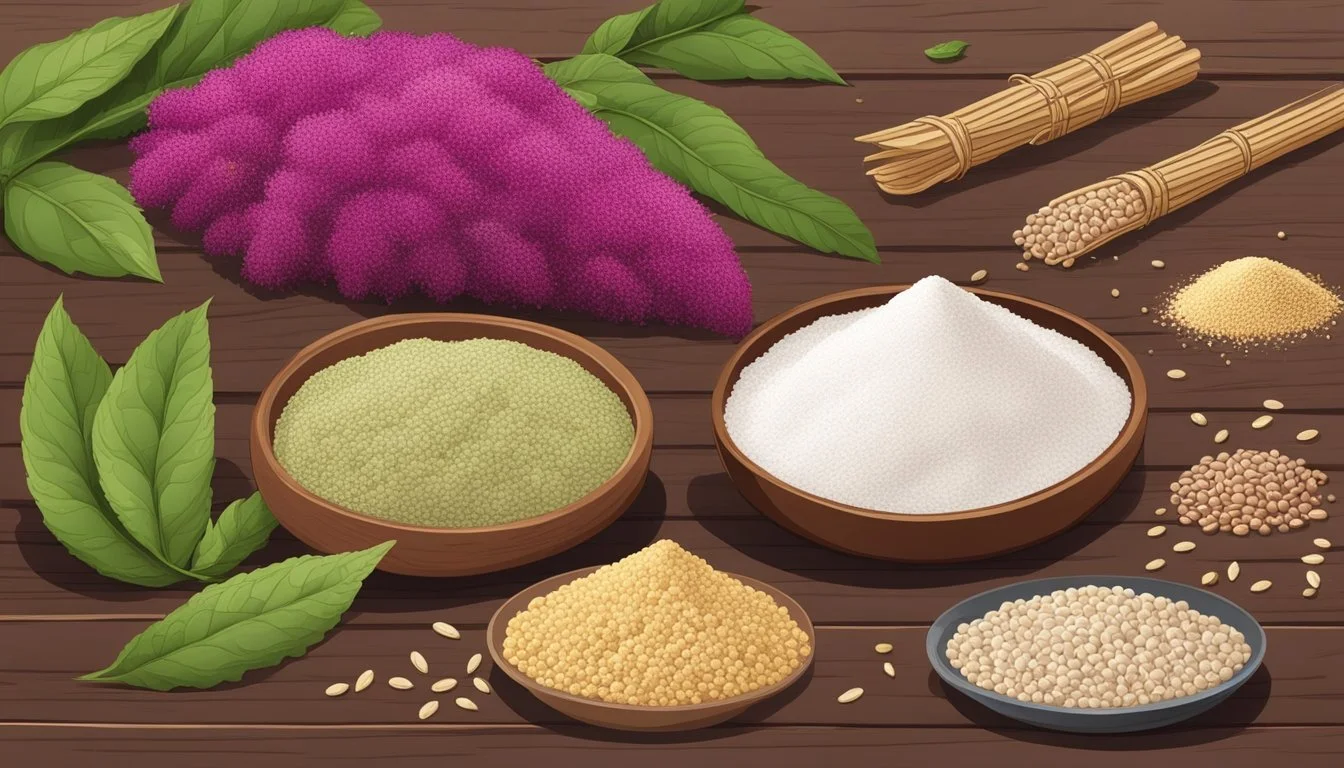How Long Does Amaranth Last?
Shelf Life and Storage Tips
Amaranth, an ancient grain that has recently gained popularity for its nutritious profile, differs from other grains when it comes to shelf life. Acknowledging the appropriate storage methods is crucial to maintaining its freshness and extending its usability. Typically, amaranth can last up to four months when stored in an open container in a pantry.
In contrast, it exhibits a longer storage life when kept in cooler temperatures. By transferring the grain to an airtight container and placing it in the freezer, it can remain viable for up to eight months. This extended longevity allows individuals to enjoy the grain's benefits over a considerable period without the loss of texture or flavor.
Understanding how to properly store amaranth ensures that its distinctive nutty taste and high nutritional value, including its rich protein and fiber content, are preserved. This makes it a reliable addition to various recipes ranging from traditional porridges to creative culinary innovations like amaranth-enhanced baked goods.
Overview of Amaranth
In exploring the longevity of Amaranth, it is essential to understand what this grain offers and its various forms. Amaranth stands out for its high nutritional value, as a protein-rich, gluten-free whole grain with a long history.
What is Amaranth?
Amaranth is considered a pseudo-grain and an ancient grain, meaning that it has been cultivated for thousands of years. Botanically known as Amaranthus, it functions similar to grains from a culinary standpoint but does not belong to the same botanical family as true grains such as wheat or rice. Amaranth is gluten-free and esteemed for its high levels of protein and fiber, making it a favorable choice for those with gluten sensitivities and individuals seeking nutritious food options.
Types of Amaranth
There are several species of Amaranth, though not all varieties are grown for consumption. The types predominantly eaten are:
Amaranthus caudatus: Also known as Love-Lies-Bleeding, it is renowned for its rope-like tassels.
Amaranthus cruentus: Often used in foods, it’s referred to as red amaranth and is noted for its striking flowers and seeds.
Amaranthus hypochondriacus: This variety is typically cultivated for its seeds and is known as Prince-of-Wales feather.
Each type offers a unique attribute to the culinary world, from colorful leaves to highly nutritious seeds, which contribute to Amaranth's standing as a versatile and healthy ingredient.
Amaranth in History and Culture
Amaranth boasts a storied past deeply rooted in the cultures and diets of ancient civilizations. It has been cultivated for thousands of years, serving as a vital crop with multifaceted uses.
Origins of Amaranth
The Amaranthaceae family, to which Amaranthus tricolor belongs, is indigenous to South America. Amaranth was domesticated there approximately 6,000 to 8,000 years ago, making it one of the oldest known food crops.
Amaranth and the Aztec Civilization
For the Aztec civilization, amaranth was not only a food staple but also an integral part of their cultural and religious practices. They revered amaranth for its nutritional value and used it in ritual offerings and ceremonies. The Hopi Red Dye amaranth, particularly noted for its vibrant hue, was widely utilized by various indigenous groups, including the Aztecs, in both food preparations and as a dye.
Cultivation Essentials
In the journey from seed to robust plant, amaranth requires attention to specific planting techniques and growth needs.
Planting Amaranth
To successfully plant amaranth in the garden, one must begin by sowing seeds directly into well-drained soil, after the last frost when the soil temperature has increased. A sowing depth of 1/8 to 1/4 inch is ideal. For gardeners preferring to start with seedlings, they should commence indoors a few weeks prior to the last expected frost. Whether direct-seeding or transplanting, space plants 10 to 18 inches apart to allow sufficient room for growth, especially for larger varieties of Amaranthus. For those with limited garden space, containers provide a viable alternative, provided they are large enough to accommodate the plant's size.
Growth Requirements
Amaranth thrives in full sun and is adaptable to a range of soil types, though it prefers a pH of 6.0 to 7.5. Seed germination typically occurs when the soil temperature is around 68°F (20°C). This resilient plant can grow in environments that would stress many other plants, making growing amaranth an excellent choice for gardeners looking to maintain food production through the hotter months. It generally does not require additional fertilizer, particularly if the soil is already rich. Regular watering is necessary, especially during prolonged dry spells, to support steady growth. Depending on the variety, one may expect a germination to harvest timeline ranging from 90 to 150 days.
Harvesting and Post-Harvest
Effective harvesting and post-harvest handling are crucial for maintaining the quality of amaranth as a food source. This section provides detailed insights into the best practices for extracting amaranth seeds and preparing them for storage.
Timing the Harvest
The optimal moment for harvesting amaranth is when seeds start to easily come off with hand-bumping and the seed heads have a majority of their seeds turning a light tan color. One should avoid harvesting too early, as seeds won't have matured fully, or too late, when excessive seed loss can occur due to shattering. Typically, this occurs after the growing season, which lasts at least 125 days for varieties such as Mercado.
Processing Amaranth Seed
After harvest, the next step is to separate the nutritious seeds from the chaff and any other debris. Seed processing involves the following steps:
Drying: Lay the harvested seed heads in a dry, well-ventilated area to prevent the growth of mold and mildew. The drying period is critical and may last several days to a few weeks, depending on humidity levels.
Winnowing: Once dried, amaranth seeds must be winnowed to remove chaff. This can be achieved by gently blowing air or tossing the seeds on a breezy day to allow the lighter chaff to blow away.
Screening: Further refinement is done by passing the seeds through screens that allow seeds to pass but not larger pieces of debris or weeds.
Inspecting for Diseases: Seeds should be inspected to ensure there are no signs of disease that could affect their viability for food.
Storage: Store the seeds in a cool, dry place in airtight containers to protect from pests and moisture, which helps maintain their nutrient content and extends shelf life.
By adhering to these harvesting and processing guidelines, one can ensure the best quality of amaranth for consumption.
Storing Amaranth
Proper storage methods for amaranth are vital to maximizing its shelf life and maintaining its quality. Different storage techniques are recommended for short-term and long-term preservation.
Short-term Storage Options
For short-term storage, amaranth should be kept in a dry, cool place, away from direct sunlight. A kitchen pantry or cabinet works well for this purpose. To prevent moisture from compromising the grain's quality, it should be placed in a dry, sealed container, such as a mason jar or a standard kitchen canister with a tight-fitting lid.
Keep amaranth in an environment with low moisture.
Use airtight containers to protect against contaminants and pests.
Label the container with the date of storage to keep track of the storage life.
Long-term Storage Guidelines
When storing amaranth for an extended period, ensuring it is completely dry before packaging is crucial. Using airtight containers is even more important for long-term storage. For maximum shelf life, one might consider using a freezer, where amaranth seeds can last up to a year, or a fridge for slightly shorter periods.
Utilize vacuum-sealed bags or airtight containers like mason jars for added protection.
Store in a cool, dry place, even when using the fridge or freezer.
Clearly label all packages with the content and the storage date.
Regularly check the amaranth for signs of spoilage like discoloration or unpleasant odors.
Cooking and Usage
Amaranth, a highly nutritious grain, is versatile in the kitchen and can be used to create a variety of dishes from breakfast to dinner, offering a healthy dose of fiber and protein.
Amaranth in the Kitchen
One can easily incorporate amaranth into their diet as it is similar to quinoa regarding nutrition and cooking techniques. Amaranth can be boiled or simmered like quinoa or millet (how long does millet last?) and is often used to make a warm porridge. A simple cooking ratio is 1:1.5, meaning for every 1/2 cup of amaranth, 1 1/2 cups of liquid is needed. Cook amaranth with water, broth, or even apple juice to expand its flavor profile. It typically takes about 20 minutes for amaranth to absorb the liquid and fully cook.
Rich in iron, fiber, and a gluten-free alternative, amaranth flour can be used in baking as well. When substituting for whole grains in recipes like muffins, using amaranth flour can add a nutty flavor and a dense texture. It is often mixed with other flours to improve the consistency of the baked goods.
Creative Culinary Ideas
Chefs and home cooks alike can get creative with amaranth to enhance their meals. It's an excellent addition to salads, providing a chewy texture and nutty essence. Amaranth pairs well with bold dressings and fresh vegetables. Mixed with herbs and vegetables, amaranth can enrich soups, making them more filling and boosting the nutrition content.
One can also create a sweetened amaranth breakfast porridge by cooking the grains with milk and brown sugar, then finishing with fresh fruit and a sprinkle of nuts. This option rivals the traditional oatmeal or other hot cereals, offering a gluten-free and protein-rich alternative. For those experiencing digestive discomfort, such as gas, from fiber-rich foods, it's advisable to soak amaranth before cooking to aid digestion.
Incorporating amaranth in various dishes allows individuals to enjoy a diverse range of flavors while taking advantage of its health benefits.
Health Benefits
Amaranth is a highly nutritious pseudo-cereal that offers notable health benefits. It is a good source of protein, essential for building and repairing tissues in the body. The protein in amaranth is particularly valuable as it contains lysine, an amino acid often lacking in grains.
Rich in fiber, amaranth aids in maintaining proper digestion. Soluble fiber helps in controlling blood sugar levels while insoluble fiber contributes to a healthy digestive tract, potentially alleviating conditions like constipation.
For individuals with celiac disease or those following a gluten-free diet, amaranth is an excellent alternative to traditional grains as it is naturally gluten-free.
Nutrients in Amaranth Benefits Protein Muscle repair and growth Fiber Digestive health Minerals Various bodily functions
Amaranth is also abundant in minerals, including calcium, magnesium, and iron, which are vital for bone health, muscle function, and oxygen transport, respectively.
Furthermore, its nutritional value extends to a range of antioxidants, such as gallic acid and vanillic acid, that combat oxidative stress and may contribute to reducing inflammation, thus aiding in the prevention of chronic diseases.
In sum, amaranth's nutritional composition, which encompasses a wealth of protein, fiber, and minerals, alongside its gluten-free nature, makes it a beneficial addition to the diet of those seeking to bolster overall nutrition and manage digestion-related issues.
Pests and Diseases
Ensuring the health and longevity of Amaranth plants in the garden requires vigilance against various pests and diseases. Effective management of these threats is crucial for a robust harvest.
Common Pests
Aphids often infest Amaranth during the summer. These tiny bugs suck sap from leaves, causing yellowing, stunted growth, and a sticky residue. Spider Mites are yet another pest, leaving Amaranth leaves speckled and wilted. Tarnished Plant Bugs can also cause significant damage by feeding on the plant's tender shoots and flowers.
Aphids:
Signs: Yellowing leaves, poor plant growth, sticky residue.
Spider Mites:
Indicators: Speckled leaves, leaf wilt.
Tarnished Plant Bug:
Symptoms: Damaged shoots and flowers.
Dealing with Diseases
Amaranth is susceptible to several diseases such as root rot, often a consequence of overwatering. Root rot's telltale sign is the wilting of leaves despite adequate soil moisture. To prevent this, gardeners must ensure proper soil drainage and avoid excessive watering. Additionally, regular pruning of Amaranth can help prevent the spread of diseases by improving air circulation and reducing the risk of fungal infections.
Root Rot:
Prevention: Proper watering, well-draining soil.
Action: Remove affected parts, use sterile potting soil if repotting.
Amaranth in Gardening and Landscaping
Amaranth is renowned in gardening and landscaping for its vibrant colors, especially the burgundy varieties, and its dual function as both an ornamental plant and a part of edible landscaping. It thrives in full sun and requires diligent care, such as regular weeding and watering, to maintain its health and productivity.
Amaranth as an Ornamental Plant
The ornamental appeal of amaranth lies in its striking foliage and tassel-like flowers, which can range in color from deep burgundy to golden yellow. In the garden, amaranth serves as a dramatic focal point due to its height—some varieties reach up to several feet tall—and its bushy flowers that add a lush texture. The plant's preference for full sun makes it an excellent choice for sunny borders and open landscapes.
Care Requirements:
Sunlight: Full sun exposure
Weeding: Regular removal of weeds
Watering: Consistent moisture, especially in dry conditions
Amaranth's foliage, apart from its aesthetic value, is also known for its tasty leaves which can add a nutritious component to a gardener's diet.
Ecological Uses of Amaranth
In an ecological context, amaranth's role extends beyond mere visual beauty. Its seed heads, bountiful and grain-filled, are particularly valuable to songbirds that depend on these resources for sustenance. This positions amaranth as a beneficial plant for supporting local wildlife and bolstering the ecological diversity of a garden.
Edible landscaping is another aspect where amaranth shines, combining functionality with sustainability. The plant's leaves are edible and are often incorporated into landscaping not only for their distinct look but also for their nutritional value. When it comes to care, gardeners must ensure amaranth has enough room to flourish, enforcing weeding practices to prevent the plant from being overwhelmed by invasive species and maintaining a regimen of watering to support its growth.
Cultural Significance
Amaranth's cultural significance is deeply rooted in history and continues to influence society today, from ancient symbolism to modern uses.
Symbolism and Traditional Uses
The amaranth plant, especially noted for its vibrant red flowers, has been a symbol of immortality and longevity dating back to the ancient Greeks, who incorporated it into their rituals. Across the ocean, in South America, the Aztec civilization held amaranth in high regard for both its nutritional and ceremonial value. They often used it during rituals associated with the fall harvest season. The Amaranthaceae family, particularly the species Amaranthus tricolor, has been widely cultivated in various cultivars, with the burgundy variety being especially prized for its aesthetic appeal.
Amaranth in Modern Society
Even today, amaranth maintains its cultural relevance. In parts of North America, the Hopi Red Dye amaranth is a key ingredient used by the Hopi people for its natural dye, which is a testament to the plant's continued traditional use. The burgundy hued red flower of certain amaranth species is not just visually striking but also a contemporary symbol of creativity and the love for the enduring beauty of nature. The presence of amaranth in modern gardens and its resurgence as a health food highlight its enduring legacy.
Amaranth Varieties and Products
The versatility of amaranth is evident in its numerous species and the range of products derived from this nutritious grain. Understanding the different species and their associated products can aid consumers in selecting the right type of amaranth for their culinary or nutritional needs.
Differentiating Amaranth Species
Amaranth encompasses a variety of species, each presenting unique characteristics. A. hypochondriacus, commonly known as Prince's Feather, has brightly colored flowers and is grown for its seeds, which are considered especially tasty when cooked. A. cruentus, also known as purple amaranth, is another widely cultivated species known for its vivid flowers and edible leaves. These species are often grown as ornamentals or for their seeds, which can be ground into flour for gluten-free recipes.
Cultivars: Selective breeding has given rise to numerous amaranth cultivars, each adapted for specific climates or uses. For example, some cultivars are optimized for leaf production and utilized as salad greens or in dishes like calaloo, while others are prized for their seeds.
Table of Differentiating Amaranth Species
Species Flower Color Seed Flavor Use A. hypochondriacus Bright red Nutty Grain production A. cruentus Purple Mild Leaves and grains
Amaranth-Based Products
Amaranth seeds boast a nutty flavor and are a gluten-free alternative to common grains. They can be cooked in their whole form, popped like popcorn for a crunchy snack, or ground into flour for baking. As a highly nutritious and versatile ingredient, amaranth features in an array of products:
Flour: An ideal gluten-free option for bread, pasta, and other baked goods.
Popped Amaranth: A light, nutritious snack that can be eaten alone or added to granolas and yogurts.
Salad Greens: The leaves of certain amaranth species are consumed raw or lightly cooked as nutritious salad greens.
Given its resilience and dietary significance, amaranth continues to be an important food source globally, especially in regions where food security is a concern.
Buying and Selecting Amaranth
When purchasing amaranth, one should consider factors like nutritional value, freshness, and whether it's sold as a whole grain. Ensuring the amaranth is of high quality is essential for enjoying its fiber-rich benefits and distinctive flavor.
Where to Purchase Amaranth
Amaranth can typically be found in health food stores, specialty grocery stores, or online markets. It's often available in various forms, including:
Whole grain: Retains most nutrients and has a longer shelf life.
Flour: Good for gluten-free baking but may have a shorter shelf life.
Puffed: A lighter option, frequently used in cereals and snacks.
One may also find amaranth at local farmers' markets, where fresh and organically grown options are sometimes available.
Quality Indicators
High-quality amaranth should exhibit the following characteristics:
Color: It should have a consistent, golden to light brown appearance.
Texture: A firm, hard texture indicates that the amaranth is not damp or spoiled.
Smell: Fresh amaranth should have a subtle, nutty scent without any hints of rancidity.
Packaging: Opt for vacuum-sealed or tightly packed containers to reduce exposure to air and moisture, which can accelerate spoilage.
Consumers should seek out amaranth that is sold as a whole grain to maximize its shelf life and ensure they are receiving the full spectrum of its nutritional benefits, including its high fiber content. It's advisable to avoid buying amaranth with signs of moisture or an off smell as these may indicate the onset of rancidity, compromising its flavorful and nutritional qualities.
Tips for Amaranth Cultivators
Amaranth thrives in warm conditions and is valued for both its leaves and seeds. Cultivators should closely monitor growing conditions to achieve the best yield.
Expert Growing Advice
Climate: Amaranth prefers a temperature range of 60°F to 95°F. Cultivators should ensure a consistent warm temperature, ideally in full sun for optimal growth.
Soil: Plant amaranth in well-drained, fertile soil rich in organic matter to support its rapid growth.
Planting: It is best to sow amaranth seeds outdoors after the last frost. For improved germination, plant seeds at a depth of 1/8 to 1/4 inch.
Space: Ensure adequate spacing in the garden. The specific space requirements will depend on the plant variety.
Watering: Consistent watering is key, especially in dry conditions. However, be cautious of overwatering, as amaranth does not tolerate waterlogged soil.
Weeding: Keep the garden free of weeds to prevent competition for nutrients and reduce the risk of diseases.
Pests: Regularly check for pests and manage them promptly to avoid damage to the plant.
Harvesting Techniques
Leaves: Young amaranth leaves can be harvested for salads about 50 days after planting. One can snip individual leaves or harvest whole stems.
Seeds: Amaranth seeds typically mature 90-100 days after planting. Harvest the grain by cutting down the flower heads and hanging them to dry before threshing.
Storage: To extend shelf life and maintain nutritional value, store amaranth grains in a cool, dry place away from direct sunlight.
By focusing on these specific practices, cultivators can successfully grow and harvest amaranth, making the most of its nutritional offerings through the summer and beyond.
Amaranth Preservation Techniques
Amaranth's shelf life can be significantly extended through proper drying and storage, as well as by taking steps to prevent spoilage and rancidity. These measures are crucial for maintaining the grain's nutritional value.
Drying and Storing Methods
After harvesting, ensuring that amaranth is completely dry is critical to prevent mold and bacterial growth. The grains should be left in a dry, warm place until they have lost all moisture. Storage conditions are equally important. Amaranth should be placed in airtight containers such as mason jars or vacuum-sealed bags to protect it from humidity and pests.
Packaging: Use airtight containers to retain dryness.
Location: Store in a cool, dark place.
Storing amaranth in a pantry or cupboard away from direct sunlight will help in maintaining its quality. Under such conditions, amaranth's storage life can reach up to six months.
Preventing Spoilage and Rancidity
To avoid spoilage and maintain the nutritional quality of amaranth, it's vital to keep air exposure to a minimum, as oxygen can accelerate the rancidity process. Use containers that have a good seal and are made of materials that do not interact with the grains.
Temperatures: Store at temperatures between 32 - 40°F (0 - 4.4°C) for optimal freshness.
Humidity: A relative humidity of 80-90% is recommended for leafy greens storage, while grains require lower humidity levels.
One should constantly check for any signs of spoilage or off-odors, which are indicative of rancidity. Removing any grains or leaves that show signs of mold can help prevent it from spreading to the rest of the product.
Future of Amaranth
Amaranth stands as a crucial grain in the global pursuit of sustainability and nutrition. It's an ancient grain, but its relevance is only growing in modern times due to its numerous benefits.
Nutritional Value: Amaranth boasts a high nutritional profile, rich in proteins, micronutrients, and amino acids, like lysine, that are often limited in other grains. Its recognition as a superfood is based on this dense nutritional value.
Gluten-Free: As dietary trends shift towards gluten-free options, amaranth's popularity may rise. Its gluten-free nature makes it a suitable food for those with celiac disease or gluten intolerance.
Sustainability: Amaranth plants are hardy and adaptable, capable of growing in less-than-ideal soils with low water requirements. This resilience could make amaranth a key player in sustainable agriculture, particularly in areas facing climate change challenges.
Cultivars and Growth: Researchers and farmers alike are interested in developing new cultivars of amaranth that maximize yield and nutritional value. The plant's ability to grow in various conditions also means it can be cultivated in diverse ecosystems around the planet.
Food Trends: As a versatile ingredient, amaranth can be used in a range of dishes. The grain's mild, nutty flavor and its ability to be popped, flaked, or ground into flour contributes to its growing trendiness in the culinary world.
In essence, the future of amaranth is intertwined with food security and health-conscious trends. Its capacity to meet the needs of a growing population makes it not just a food of the past, but a grain of the future.
Common Questions about Amaranth
In discussing Amaranth, common inquiries usually revolve around its culinary uses and the best methods of storage for longevity.
Culinary Queries
Amaranth enjoys a rich history as both a decorative plant and a nutritious grain. One might ask, "Is Amaranth a true grain?" Despite its grain-like seeds and frequent descriptive term "ancient grain," it is technically a pseudocereal related to beets and chard.
Can Amaranth be eaten raw? While it can be consumed raw, it's often cooked to improve digestibility and nutrient absorption.
What is the taste of Amaranth? Its seeds have a mild, nutty flavor and are versatile enough to be popped like popcorn, boiled like rice, or incorporated into various dishes.
Storage FAQs
When it comes to storing Amaranth, whether in seed form or after cooking, certain practices ensure longevity.
Shelf life of raw Amaranth seeds: Under proper conditions, Amaranth seeds can last up to 6 months in the pantry and about a year if stored in the freezer.
Cooked Amaranth preservation: It should be refrigerated where it can last for approximately a week. Avoid leaving it at room temperature for extended periods to prevent spoilage.
















